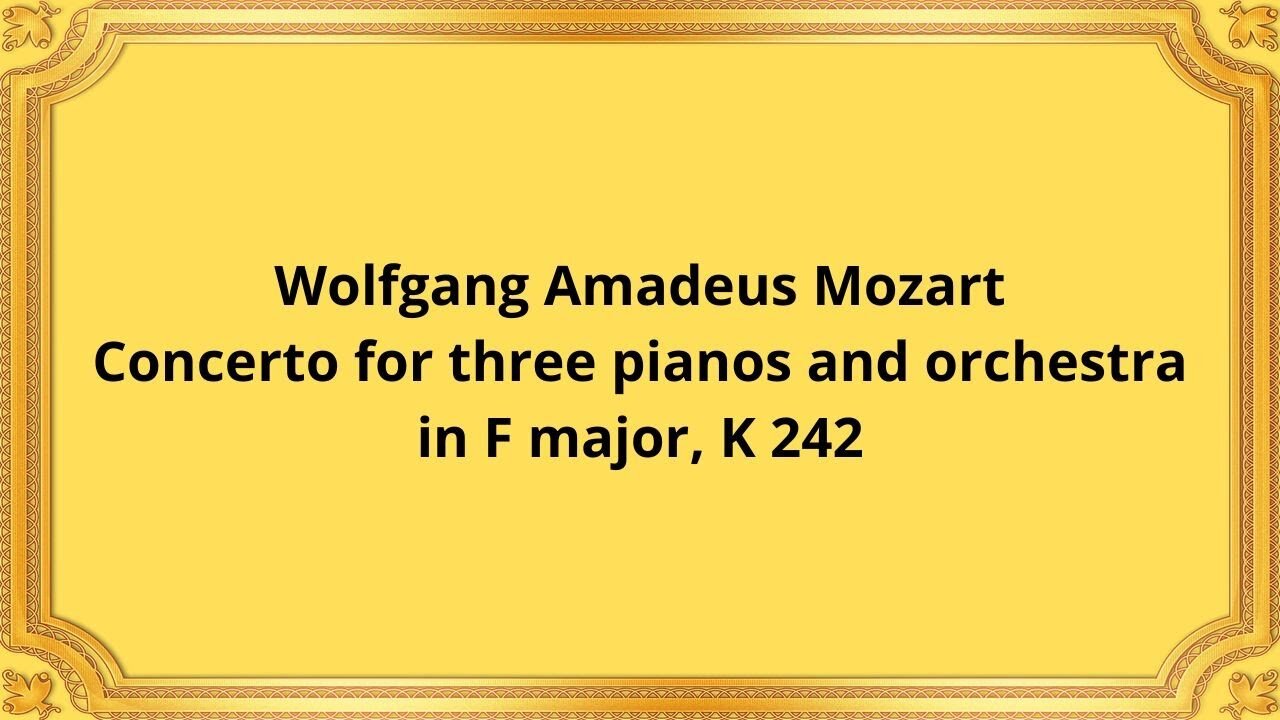Premium Only Content

Wolfgang Amadeus Mozart Concerto for three pianos and orchestra, in F major, K 242
#Mozart #Concerto #ClassicalMusic #ThreePianos #Orchestra #FMajor #K242 #MusicalComposition #chambermusic #concert #piano
Publication date 1964
Pierre Sancan, Jean-Bernard Pommier, Catherine Silie—soloists
Orchestra of the Association of Lamoureux Concerts Dimitri Chorofas, conductor
Wolfgang Amadeus Mozart, a musical prodigy and one of the greatest composers of all time, left an indelible mark on the world of classical music. Among his remarkable compositions, the Concerto for Three Pianos and Orchestra in F major, K 242, stands out as a testament to his exceptional talent and innovative spirit.
Composed in 1776, during Mozart's fruitful years in Salzburg, the Concerto for Three Pianos and Orchestra in F major, K 242, showcases the composer's remarkable ability to create harmonious collaborations between multiple instruments. During this period, Mozart was establishing himself as a prolific composer and performer, captivating audiences across Europe. This concerto serves as a testament to his innovative spirit and his quest for musical exploration.
Mozart's Concerto for Three Pianos and Orchestra in F major is composed of three movements: Allegro, Adagio, and Rondeau: Tempo di Minuetto. The opening Allegro movement introduces the listener to the energetic and joyful interplay between the three pianos and the orchestra. The Adagio movement follows, providing a contrasting and introspective atmosphere, as the pianos engage in a heartfelt musical dialogue. Finally, the Rondeau: Tempo di Minuetto movement concludes the concerto with its lively and dance-like rhythm, showcasing Mozart's ability to create enchanting melodies that captivate the listener's imagination.
The Concerto for Three Pianos and Orchestra in F major exhibits Mozart's mastery in composing for multiple pianos, a rarity during his time. The piece highlights his skill in balancing and blending the sounds of the three pianos, creating a harmonious and rich musical texture. Mozart's use of intricate harmonies, stunning cadenzas, and virtuosic passages showcases his brilliance as a composer and his ability to push the boundaries of musical expression.
Mozart's Concerto for Three Pianos and Orchestra in F major, K 242, holds a significant place in the classical music repertoire. Its unique composition and captivating melodies have ensured its popularity throughout the centuries. The concerto's enduring appeal has led to its inclusion in numerous performances and recordings, captivating audiences worldwide. Mozart's ability to create a seamless musical conversation between the pianos and the orchestra continues to inspire and influence musicians and composers to this day.
Conclusion:
Wolfgang Amadeus Mozart's Concerto for Three Pianos and Orchestra in F major, K 242, is a testament to his exceptional talent and innovative musical genius. Its historical significance, captivating musical structure, and enduring impact on the classical music landscape have solidified its place as a cherished work. Through its harmonious collaboration, intricate harmonies, and virtuosic passages, this concerto continues to captivate audiences, allowing Mozart's musical legacy to thrive and inspire generations to come.
You have the opportunity to support the channel:
https://destream.net/live/RadSiarAl/donate
https://www.buymeacoffee.com/6355radsiaral
-
 LIVE
LIVE
LFA TV
13 hours agoDING DONG THE BILL IS DEAD! | LIVE FROM AMERICA 12.19.24 11am EST
5,274 watching -
 37:31
37:31
BonginoReport
5 hours agoShut It Down (Ep.108) - 12/19/2024
77.6K212 -
 LIVE
LIVE
Vigilant News Network
17 hours agoBUSTED: ‘The View’ Co-Host May Face Criminal Investigation | The Daily Dose
1,653 watching -
 2:02:09
2:02:09
Film Threat
15 hours agoSUPERMAN TRAILER LIVE REACTION | Film Threat Livecast
61K6 -
 47:27
47:27
PMG
11 hours ago $0.09 earned"Hannah Faulkner and Jeremy Harrell | LIVE FROM AMERICA!!!"
4.84K -
 1:03:14
1:03:14
2 MIKES LIVE
2 hours agoTHE MIKE SCHWARTZ SHOW with DR. MICHAEL J SCHWARTZ 12-19-2024
29.1K5 -
 4:45
4:45
Gamazda
16 hours ago $14.16 earnedGuns N' Roses - Sweet Child O' Mine
75.6K50 -
 1:25:28
1:25:28
CarlCrusher
18 hours agoUFO Plasma ORBs & Drones Above New Jersey | Catching REAL PROOF with Dr Jim Segala
63.7K36 -
 24:40
24:40
Degenerate Plays
1 day ago $4.33 earnedI Put A Bounty On This Phone Addict - Madden NFL 09 : Part 1
39.9K1 -
 18:29
18:29
Bearing
1 day agoCrazy Democrat Lady Thinks THE DRONES Are Coming For TRUMP & MAGA
35.1K63